2023 Management Strategies for Goss's Wilt and Tar Spot in Corn
What are diseases Goss’s Bacterial Wilt and Tar Spot fungus and why is there a concern?
Goss’s Wilt is a bacterial disease found in corn. The bacteria shuts down the pipeline of nutrients and water from traveling up and down the stalk causing the plant to die. It seems to really affect the crop late July through early September during hot-dry conditions. Goss’s Wilt can be found on the vast majority of corn acres in the Midwest, the Eastern Corn Belt and even the Western Corn Belt. The disease can produce yield losses of 50 bu/A or higher due to the premature death of the corn plant before it is able to reach its potential.
Goss’s Wilt of corn causes long and large brown lesions on the leaves that appear water soaked. The lesions have black freckles and when a corn leaf is held up towards the sun, they are quite visible. This is the best way to identify the disease as no other corn disease displays the freckles. It also displays brown mottles on the bottom part of the stalk. Goss’s Wilt was discovered by plant pathologist R. W. Goss from the University of Nebraska. The disease forms a leaf lesion at the onset and then progresses further into the plant where it shuts down the xylem and phloem flow up and down the plant. Consequently, the plant can’t get needed water and food to thrive and shuts down, which leads to a smaller yield, lower test weight and possibly higher moisture corn due to the inability of the plant to dry down naturally.
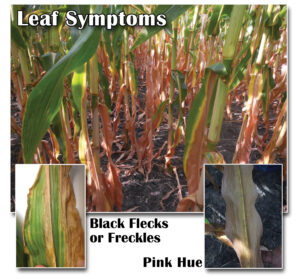
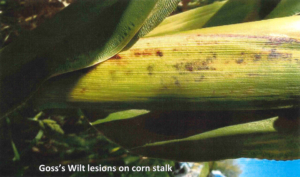
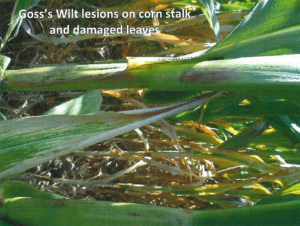
The newer version of Goss’s Wilt displays a pinkish color on the leaves. It waits for a lesion or wound to form and uses it as an entrance into the plant. Wind of hail can cause wounds to the leaves and/or stalk, which allows Goss’s Wilt to enter and populate the plant. It typically starts at the top of the plant and works its way down. However it can also start at the bottom and work up. If the infection gets a foothold, up to 100 bu/A can be lost.
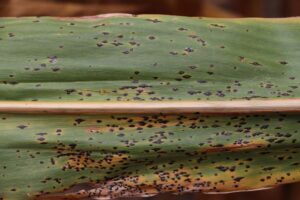 Tar Spot is a fungal disease that causes black specks to form on the leaves. Those black areas aren’t fungal spores; they’re manganese oxide.
Tar Spot is a fungal disease that causes black specks to form on the leaves. Those black areas aren’t fungal spores; they’re manganese oxide.
“That’s the black stuff that doesn’t rub off the leaf surface,” said Dr. Don Huber, a professor emeritus of plant pathology at Purdue University, who added that manganese oxide piles up in Tar Spot-infected areas. “There can be 10,000 to 12,000 parts per million (ppm) of oxidized manganese in these tar spots, which is a phenomenal quantity.”
It’s also common to see a yellow “halo” around the Tar Spot lesions. In these areas, manganese levels are zero or barely detectable. As Tar Spot invades plant tissue, it creates a manganese deficiency, which destroys the plant’s ability to photosynthesize. “As Tar Spot ‘mines’ manganese, the plant goes into an energy deficit,” Huber said. “The disease also diminishes the plants’ ability to defend itself against pathogens.”
“In the last three to four years, Tar Spot has become a major challenge,” said Huber, “It’s running rampart in many areas, ranging form low disease pressure to high disease pressure.
Tar Spot has been found in most of the Midwest, part of the Eastern Corn Belt and part of the Western Corn Belt and is expected to keep spreading. Tar Spot is a fungus that favors wet leaves, dewy mornings, high humidity and moderate temperatures.
Interaction of Goss’s Wilt & Tar Spot
Goss’s Wilt shuts down the plant’s immune system and allows Tar Spot to attack when the plant is the most susceptible. Goss’s Wilt affects the nutrient and water flow and while the plant is suffering, it allows disease such as Tar Spot to infect it. Both pathogens also readily survive in infected residue on the soil surface, serving as the primary inoculant source for future crops.
Reduce or eliminate fungicide application
Because Goss’s Wilt is caused by bacteria, the application of a fungicide is ineffective in offering protection or control. Fungicide applied to seed, soil or crop foliage disseminates the beneficial fungi, such as mycorrhizal fungi, trichoderma fungi and penicillium fungi. Beneficial fungi are important in soil and plant health. Crop residue digestion and nutrient cycling is driven by the beneficial fungi. There are alternative approaches to suppress and control plant disease in corn such as Goss’s Wilt and Tar Spot.
If Tar Spot has hit your area – and fungicides aren’t controlling the disease – there’s a reason why. To understand what’s going on with any new or emerging disease, it’s important to look at what has changed. “It will be genetics or environmental conditions.” Huber said.
Beware of glyphosate
What has changed that’s allowing Tar Spot to spread so quickly? Huber cites genetic engineering that has enabled crops’ resistance to glyphosate. To achieve this, plant breeders went back to some older inbreds that were susceptible to some diseases.
This also explains why Goss’s Wilt has become much more of a challenge. “Goss’s Wilt was known for decades before genetic engineering, but it had never moved out of seven counties in eastern Nebraska until recent years,” Huber said.
Glyphosate is a strong chelator that can shut down multiple sources of resistance to diseases, hindering plants’ immune system. “The plant breeders discounted this risk factor,” Huber said.
Glyphosate is stimulating the Tar Spot pathogen. Glufosinate products like Liberty are in the same category as glyphosate when it comes to the Tar Spot issue, Huber added. “Some farmers say they can’t give up glyphosate. I say, ‘Good luck controlling Tar Spot.’”
Control Stages for Goss’s Wilt and Tar Spot
The key to controlling these two diseases is to plan ahead and take preventative action throughout the growing season. Begin by choosing a highly tolerant hybrid if you’ve had Goss’s Wilt or Tar Spot in the past. Tolerant hybrids will fend off the infection much more than susceptible hybrids.
In-season soil health and plant health is important to avoid these two corn diseases. Microbial diversity can help to maintain the plant’s immune system. Basically the good guys will fend off the bad guys. At stage V5-V6 it is helpful to do a tissue test and supply the needed nutrients. Pay close attention to trace elements especially manganese, copper, zinc, sulfur, and boron. All of these nutrients are often overlooked but are critical to building the plant’s immune system. The brix level in the plant is also an important thing to consider, a high brix plant of 16 brix or higher would be more equipped to fight off these diseases. In order to achieve high brix, you must have balanced nutrition in the plant including trace elements.
Adding a foliar program at V4 to V5 and V8 to V10 will also help suppress Goss’s Wilt and Tar Spot
After harvest, it can also be beneficial to treat the corn residue left in the field where Goss’s Wilt and Tar Spot where they can overwinter. By increasing the rate of decomposition, it may help reduce the amount of Goss’s Wilt and Tar Spot inoculum in the field.
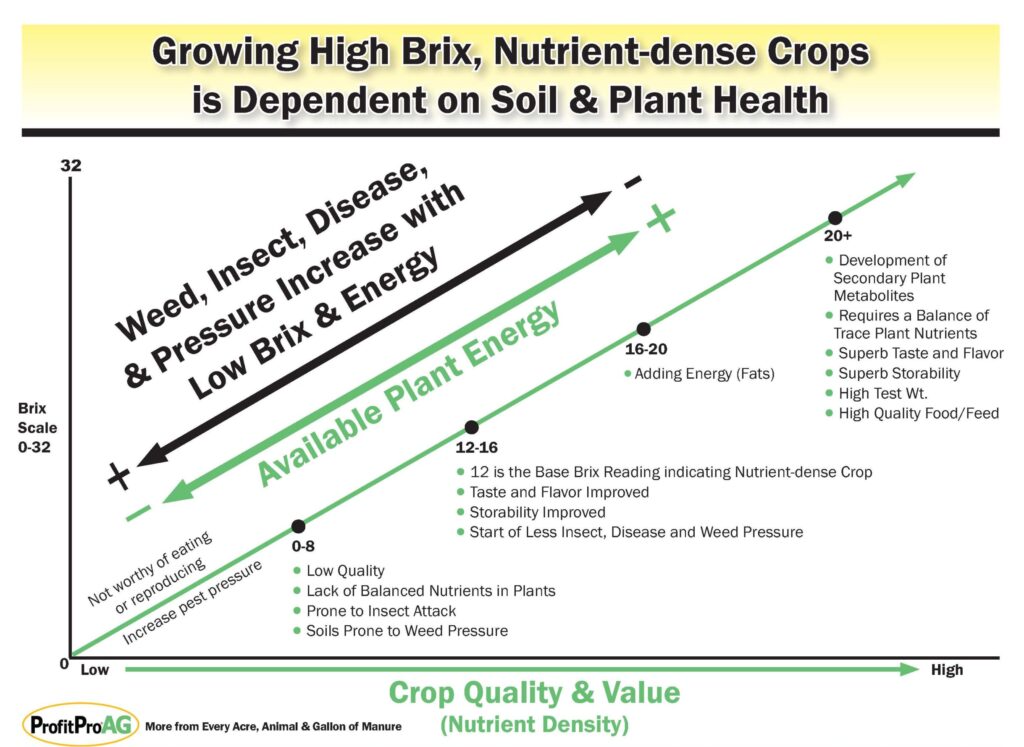
In-season stay green and why
In order for corn to achieve a high yield potential, it needs to be able to stay green so that it can more completely fill the ear at the end of the season. Often times you will see corn turning yellow, off green or just plain dying in mid-August through mid-September. When this happens, Goss’s Wilt or Tar Spot may be the culprits caused by lack of balanced nutrition.
Stay green is also important because it allows for more glucose production by the plant. It takes about 100 pounds of glucose to produce one bushel of corn. Also, fifty percent of the glucose is exudated from the roots into the soil feeding the soil microbiome. The microbes through respiration of glucose, produce CO2, which finds its way to the corn canopy for absorption by the plant to drive yield.
Healthy soil and a complete plant nutrition program, including the trace minerals, such as Mn, Cu, Zn and B, will aid in controlling plant disease. It’s the trace elements that drive high brix, nutrient dense crops and development of secondary plant metabolites.
You can choose to apply a foliar program at both V4 to V5 and V8 to V10 or just V8 to V10.
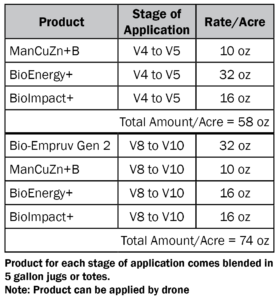 Bio Empruv Gen 2 (0-9-6) is a blend of biological stimulants, natural fermentation extracts, natural surfactants and microbial metabolites. Bio Empruv Gen 2 stimulates the plant’s defense mechanism and improves resistance against many environmental and physiological disorders, including Goss’s Wilt and Tar Spot. When combined with a trace element package such as ManCuZn+B, bacterial and fungal diseases can be suppressed.
Bio Empruv Gen 2 (0-9-6) is a blend of biological stimulants, natural fermentation extracts, natural surfactants and microbial metabolites. Bio Empruv Gen 2 stimulates the plant’s defense mechanism and improves resistance against many environmental and physiological disorders, including Goss’s Wilt and Tar Spot. When combined with a trace element package such as ManCuZn+B, bacterial and fungal diseases can be suppressed.
BioEnergy+ is composed of 15 components that supply nutrition and energy to the developing plant. BioImpact+ is a spray adjuvant consisting of chitosan, ethylene inhibitor, yucca and quillaja. This combination aids in foliar spraying, sticking to and penetrating the leaves.
The component chitosan is a non-toxic, biodegradable product derived from one of the most abundant organic polymers in nature. Chitosan targets chitin, the main component of insects’ exoskeletons. Harmful fungi and disease pathogens also contain chitin. Chitosan helps break down chitin for greater insect and disease suppression, which promotes healthier crops.
When a plant is stressed, it produces ethyene which causes the plant to become senescence and shut down. The ethylene inhibitor in BioImpact+ retards that process. Both Yucca and Quillaja, two natural plant extracts will also aid in disease and insect suppression. The combination of these product technologies applied at the right stage of corn development will boost your crop’s immune system and yield potential. This approach could mean another 80 to 100+ bushels on your bottom line. You already have invested financially in putting the crop in the ground, why not protect and leverage that investment.
Let’s talk. Ready to take control of Goss’s Wilt and Tar Spot? ProfitProAG can help you design a plan tailored to your acres. Contact us for more details.
Office – 507-373-2550 / info@profitproag.com
Dr. Jim Ladlie – 507-383-1325 / jladlie@profitproag.com
Dennis Klockenga – 320-222-1608 / dklockenga@profitproag.com
Tony Ritten – 715-501-0190 / tritten@profitproag.com
John Pernat – 920-285-2400 / johndpernat@gmail.com
